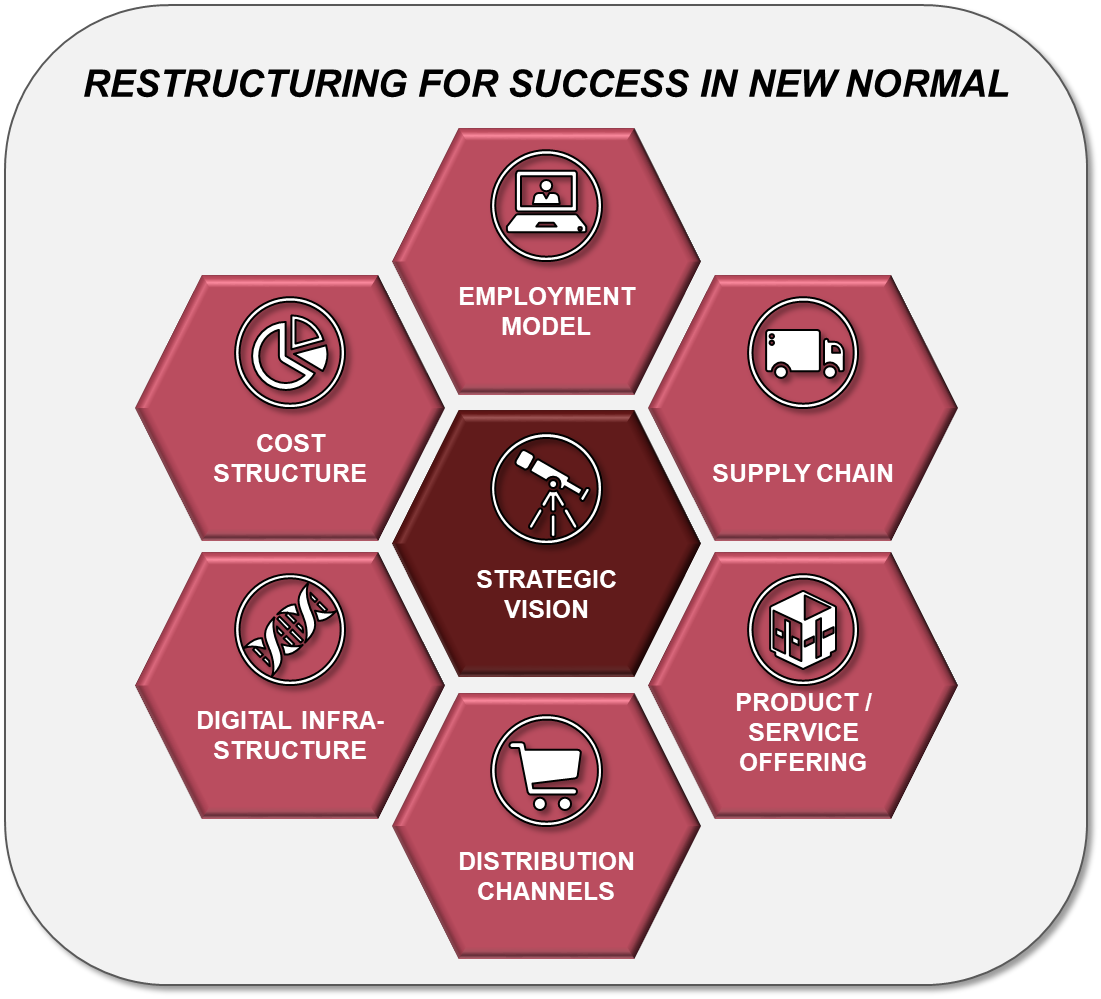THE COVID-19 CRISIS HAS PROFOUNDLY SHAKEN THE ECONOMY
The world has changed. The novel coronavirus (2019-nCoV) has seen to that. As well as affecting
countless lives, COVID-19 has unleashed a devastating blow to the global economy, disrupting supply and choking off demand. Safeguarding and stabilizing operations, liquidity, employees, supply chains and markets has been the overwhelming first priority. Now, companies must start thinking strategically about how they will adapt as the pandemic and markets evolve.
Even for those who feel able to predict the passing of the storm, counting on a quick return to business as usual is not a viable strategy. The shock of the pandemic on previous assumptions and future behavior can’t be ignored even if there is a sharp V-shaped recovery. A slower U-shaped recovery or a longer L-shaped recession will have even more profound implications. Whatever the path forward, the world will be different and companies need to plan for a new
normal.
QUESTIONING BUSINESS MODEL FOUNDATIONS IS THE FIRST STEP FORWARD
The new post-COVID normal will be very different from what we assumed before the crisis. Change for companies won’t stop at simply replacing travel with virtual meetings. In order to be competitive in the post-COVID world, many business models and strategies will need to be challenged and potentially overhauled. Companies should revisit the assumptions they held about their strategy, and consider 6 key questions.
Answers to these key questions are central for determining the shape things to come. While some trends that we have been following for quite some time will be greatly accelerated by the COVID-19 pandemic, for example digitization and online sales, in other areas it will be a watershed changing the direction of travel, for example global maximum-efficiency supply chains. Understanding the new normal will mean breaking with many preconceived notions, and
keeping an open mind in response to fresh ideas.
COMPANIES MUST RESTRUCTURE FOR SUCCESS IN THE NEW NORMAL
As the initial wave of transmission passes and lockdown measures are eased in many countries, leadership is turning its sights on regrouping. Leaders are expected to lay out a strategic vision for their companies that will lead to success in the new normal. Restructuring the cost structure, employment model, supply chain, product / service offering, distribution channels and digital infrastructure will create a strong foundation for a robust growth-oriented strategy.
COST STRUCTURE - Businesses are facing intensifying pressure to contain and reduce fixed costs. To ride out the crisis companies have deployed stop-gap measures, such as furloughs, hiring freezes and discretionary cost controls. However, these measures are rapidly escalating into
full-fledged layoffs and major investment revisions as companies look to draw down fixed costs.

EMPLOYMENT MODEL - Companies are studying lessons learned from the COVID-induced lockdowns with the goal of improving employee welfare, increasing flexibility and reducing costs. Human resource models that provide flexibility around a permanent core are likely to gain ground. Institutionalizing remote working, increasing automation and reducing the real estate footprint will increase productivity and efficiency.
SUPPLY CHAIN - Ensuring a high-functioning supply chain is a critical concern going forward. Companies will prioritize the development of alternate sourcing options and invest in understanding the financial and operational health of their suppliers. Extending visibility deeper into suppliers. networks is central to assess and manage supply chain risks and for smart scenario
planning.
PRODUCT / SERVICE OFFERING – During the lockdown clients were
forced to experiment with new products and have discovered new needs. Forward
looking companies are already reassessing their offering and considering new
product lines and services to fit new demand patterns. Staying attuned to
customers means expanding the company's offering to suit disparate reactions by
clients to the pandemic.
DISTRIBUTION CHANNELS – Adjusting a company's channel mix is a
tricky and sensitive business, but the COVID-19 crisis is demonstrating how a
well-balanced distribution system is crucial for resilience. Companies will
increase their online presence to tap into this growing stream but will
also look to a wider network of outlets and delivery pick-up sites to cater
for increased local shopping as remote working and environmental awareness
influence shopping habits.
DIGITAL INFRASTRUCTURE - The experience of COVID-19 will
accelerate momentum towards digital ways of working. The crisis has made
clear the benefits of strong digital infrastructure and automated operations.
Greater investments in these areas will equip companies to maintain better
business continuity in their supply chains, operations and customer management,
reducing their dependence on human resources.
A COHERENT STRATEGY IS REQUIRED TO EMERGE FROM
VULNERABILITY TO STRENGTH
COVID-19 has reminded the world of its vulnerability and
heightened the awareness of the public and wider society to global risks.
Across the board, companies will examine their approach to risk with a fresh
eye and consider what measures are needed to fortify their business models. Companies
will need to implement structural measures including cost containment measures,
employment model revision, supply chain restructuring, product offering
reassessment, distribution channel diversification and digital transformation
acceleration. Leaders play a crucial role in providing a coherent strategy to
reposition their companies for success in the post-crisis
world, and to emerge stronger and better prepared
to face future crises.